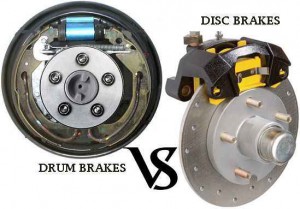Early automotive brake systems, after the era of hand levers of course, used a drum design at all four wheels. They were called drum brakes because the components were housed in a round drum that rotated along with the wheel. Inside was a set of shoes that, when the brake pedal was pressed, would force the shoes against the drum and slow the wheel. Fluid was used to transfer the movement of the brake pedal into the movement of the brake shoes, while the shoes themselves were made of a heat-resistant friction material similar to that used on clutch plates.
This basic design proved capable under most circumstances, but it had one major flaw. Under high braking conditions, like descending a steep hill with a heavy load or repeated high-speed slow downs, drum brakes would often fade and lose effectiveness. Usually this fading was the result of too much heat build-up within the drum. Remember that the principle of braking involves turning kinetic energy, wheel movement, into thermal energy (heat). For this reason, drum brakes can only operate as long as they can absorb the heat generated by slowing a vehicle’s wheels. Once the brake components themselves become saturated with heat, they lose the ability to halt a vehicle, which can be somewhat disconcerting to the vehicle’s operator.
Disc Brakes
Though disc brakes rely on the same basic principles to slow a vehicle,friction and heat, their design is far superior to that of drum brakes. Instead of housing the major components within a metal drum, disc brakes use a slim rotor and small caliper to halt wheel movement. Within the caliper are two brake pads, one on each side of the rotor, that clamp together when the brake pedal is pressed. Once again, fluid is used to transfer the movement of the brake pedal into the movement of the brake pads.
But unlike drum brakes, which allow heat to build up inside the drum during heavy braking, the rotor used in disc brakes is fully exposed to outside air. This exposure works to constantly cool the rotor, greatly reducing its tendency to overheat or cause fading. Not surprisingly, it was under racing circumstances that the weaknesses of drum brakes and the strengths of disc brakes were first illustrated. Racers with disc brake systems could carry their speed ‘deeper’ into a corner and apply greater braking force at the last possible second without overheating the components. Eventually, as with so many other automotive advances, this technology filtered down to the cars driven by everyday people on public roads.







